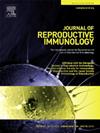The NLRP3 activation-related signature predicts the diagnosis and indicates immune characteristics in endometriosis
IF 2.9
3区 医学
Q3 IMMUNOLOGY
引用次数: 0
Abstract
Endometriosis (EMS) is a prevalent gynecological disease that leads to chronic pelvic pain and infertility in women of reproductive age. However, the underlying pathogenic genes and effective treatment for EMS remain unclear. Therefore, this study aims to identify key genes influencing the diagnosis and treatment of EMS. The GSE7307 dataset, comprising 18 EMS and 23 control samples, was obtained from the GEO database. Fourteen differential genes related to NOD-like receptor protein 3 (NLRP3) activation and EMS were extracted from endometrial samples in GSE7307 through differential analysis. GO and KEGG analyses revealed that these genes were primarily involved in the production and regulation of the cytokine IL-1β and the NOD-like receptor signaling pathway. Random Forest (RF) and support vector machine recursive feature elimination algorithms were employed to select four diagnostic markers related to NLRP3 activation (NLRP3, IL-1β, LY96, and PDIA3) for constructing the EMS diagnostic model. These markers were validated using western blotting and tested in GSE7305 and GSE23339 datasets. The AUC values demonstrated the model's robust diagnostic performance. Additionally, the infiltration of immune cells in the samples and the correlation between different immune factors and diagnostic markers were explored. These results suggest that the four diagnostic markers may also play a crucial role in EMS immunity. Finally, the DrugBank database indicated that niclosamide could be effective for NLRP3-targeted therapy. In conclusion, we identified four key diagnostic genes for EMS, and niclosamide emerged as a potential drug for NLRP3-targeted therapy in EMS.
求助全文
约1分钟内获得全文
求助全文
来源期刊
CiteScore
6.30
自引率
5.90%
发文量
162
审稿时长
10.6 weeks
期刊介绍:
Affiliated with the European Society of Reproductive Immunology and with the International Society for Immunology of Reproduction
The aim of the Journal of Reproductive Immunology is to provide the critical forum for the dissemination of results from high quality research in all aspects of experimental, animal and clinical reproductive immunobiology.
This encompasses normal and pathological processes of:
* Male and Female Reproductive Tracts
* Gametogenesis and Embryogenesis
* Implantation and Placental Development
* Gestation and Parturition
* Mammary Gland and Lactation.

 求助内容:
求助内容: 应助结果提醒方式:
应助结果提醒方式:


